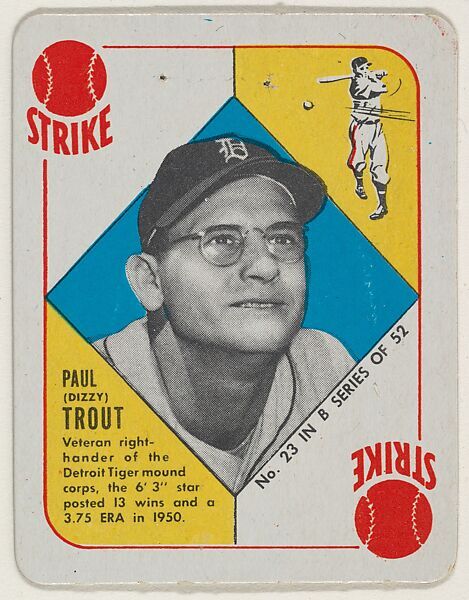
A Glimpse into Post-War American Cards
When we previously explored the 1951 Topps Red Backs, we celebrated Topps’ early ingenuity in entering the baseball card market. Today, we turn our attention to their counterpart: the 1951 Topps Blue Backs. In 1951, as America leaned into the post-war boom, the nation was captivated by baseball, music, and the rise of pop culture. Eager to innovate and join the rising tide, Topps introduced its debut set, the Red Backs, and a “B-series” known as the Blue Backs — a dual set of baseball cards that not only celebrated the sport but also mirrored the cultural zeitgeist of the time.
The Blue Backs were released after the Red Backs, in the late Spring of 1951.
1951 Blue Backs Design and Roster
The 1951 Topps Blue Backs set consists of 52 cards, each measuring 2″ x 2-5/8″ with rounded corners, resembling playing cards. Each card features a black-and-white headshot of a player set against a vibrant background, with the card’s back colored blue, distinguishing it from its Red Back counterpart.
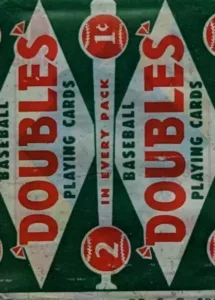
1951 Topps Blue Backs Pack Wrapper
Notably, the Blue Backs boast a roster entirely distinct from the Red Backs, showcasing a different selection of players from the era. The checklist of players featured on the Blue Backs is not quite as impressive as that highlighted in the Red Backs series, but due to scarcity, the Blue Backs tend to be slightly more valued by collectors.
Cultural Touchstones
The year 1951 was significant in baseball history. The New York Yankees clinched the World Series title, defeating the New York Giants in six games. This series was particularly memorable as it marked the final championship appearance for Joe DiMaggio and the debut for rookies Mickey Mantle and Willie Mays.
The excitement surrounding the Subway Series between the Yankees and Giants added to the allure of baseball in New York, further fueling the popularity of novelties and baseball collectibles, including the Topps Blue Backs.
Beyond baseball, 1951 was a vibrant year in American culture. Music charts were dominated by hits like “Be My Love” by Mario Lanza and “Cry” by Johnnie Ray. The early 1950s also saw the rise of various board games and the continued popularity of classic toys, reflecting a burgeoning consumer culture.
Collectability and Value
Today, due to a discovery of untouched Red Backs cards in the Philadelphia area in the late 1970s, the 1951 Topps Blue Backs are considered scarcer than the Red Backs, making them particularly treasured by collectors. This scarcity often translates to higher values, especially for cards featuring common players in good condition.
The cards were intended for use as a way of simulating a baseball game, and children seem to have enjoyed playing it. It’s notable that the only “Home Run” card in the Blue Backs set was card #49, Hank Sauer — a card that has never been graded at PSA 10 and is extremely rare at PSA 9.
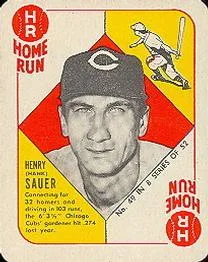
1951 Topps Blue Backs #49 Hank Sauer
The combination of their unique design, distinct player roster, and the rich historical context of their release year makes the Blue Backs a cherished piece of baseball and American history. Collecting these cards provides a tangible connection to the players, events, and societal shifts of the early 1950s.
Key Cards in the 1951 Topps Blue Backs Set
While the 1951 Topps Blue Backs may not feature the same Hall of Fame firepower as the Red Backs, the set offers plenty of notable players from the golden age of baseball. From All-Stars to fan favorites, these cards provide a rich snapshot of the sport in the early 1950s.
Eddie Yost (#1)

1951 Topps Blue Backs #1 Eddie Yost
Eddie Yost was a master of plate discipline long before on-base percentage became a widely appreciated stat. As the leadoff hitter for the Washington Senators, Yost was one of the most patient batters of his era, regularly drawing over 100 walks a season. By 1951, he was already well established as the “Walking Man,” leading the American League in walks four times before his career was over. His Blue Backs card is a great representation of the kind of underrated players that Topps featured in their early sets. While not a slugger, Yost’s ability to get on base made him an invaluable table-setter. The Yost card can be tough to find in pristine condition due to wear and tear from being the top card in collector’s stacks.
Richie Ashburn (#3)
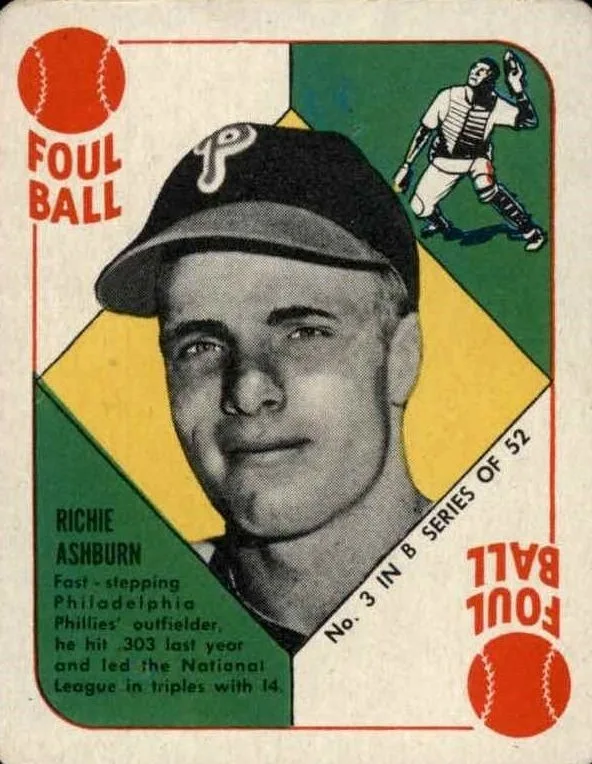
1951 Topps Blue Backs #3 Richie Ashburn
By 1951, Richie Ashburn had already cemented himself as one of the best contact hitters in baseball. A key figure on the Philadelphia Phillies “Whiz Kids” team that won the National League pennant in 1950, Ashburn was known for his speed, his ability to hit for average, and his elite defense in center field. A two-time batting champion and Hall of Famer, Ashburn’s Blue Backs card is one of the set’s highlights. While many collectors chase power hitters, Ashburn’s card represents a different kind of excellence — the kind that helped a team win games with speed, defense, and a high batting average.
Enos Slaughter (#30)
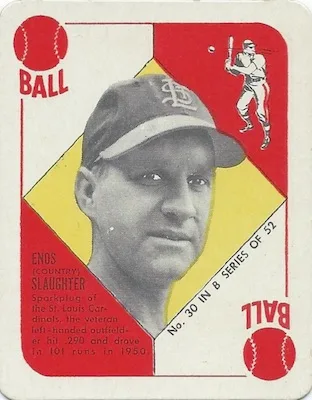
1951 Topps Blue Backs #30 Enos Slaughter
Enos Slaughter, known for his “Mad Dash” in the 1946 World Series, was one of the game’s toughest competitors. By 1951, he was a 10-time All-Star and an established star for the St. Louis Cardinals. Slaughter’s rough playing style anticipated the hustle that would characterize the career of Pete Rose, but there are also accounts that Slaughter was intentionally antagonistic to Jackie Robinson during Robinson’s debut season.
Johnny Mize (#50)
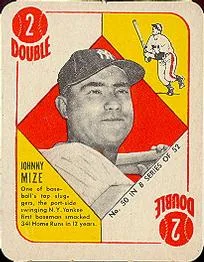
1951 Topps Blue Backs #50 Johnny Mize
At the tail end of his career in 1951, Johnny Mize was still a feared power hitter. A multi-time home run champion and Hall of Famer, Mize played a key role as a veteran bat off the Yankees bench. His Blue Backs card is a fascinating collectible because it captures him in the final stretch of a storied career. His career numbers are striking despite losing three seasons to military service: 359 HR, a .312 batting average, and more than two thousand hits.
Dizzy Trout (#23)
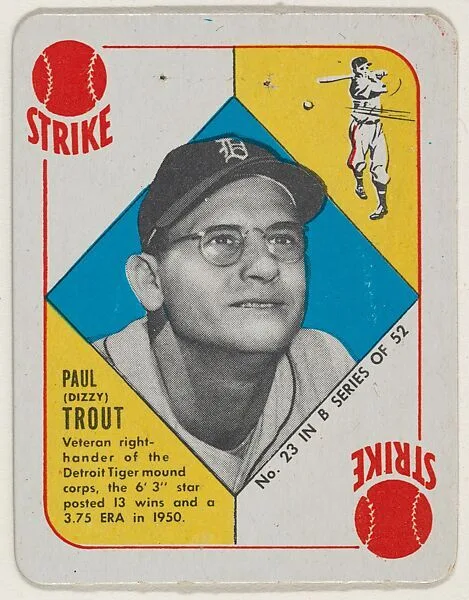
1951 Topps Blue Backs #23 Dizzy Trout
Dizzy Trout may not be as well-remembered today as some of his contemporaries, but in the 1940s, he was one of the most dominant pitchers in the American League. A key part of the Detroit Tigers rotation, he won 27 games in 1944 and was a major contributor to their 1945 World Series championship. By 1951, he was in the twilight of his career, but he still had the reputation of a tough, durable pitcher. His Blue Backs card serves as a reminder of his impact during the war years and his role in Tigers history.
The Legacy of the 1951 Topps Blue Backs
Though often overshadowed by the 1952 Topps set, the 1951 Blue Backs continue to gain recognition in the history of baseball cards. Their game-inspired design, scarce print run, and selection of key players make them a fascinating chase for collectors. Whether it’s the beloved Richie Ashburn, the prodigious power of Johnny Mize, or the historical significance of Dizzy Trout, these cards offer a true glimpse into the baseball world of the early 1950s.
For collectors and fans alike, the Blue Backs serve as a reminder of an era when a simple pack of cards could capture the magic of the game.